Security Market Size
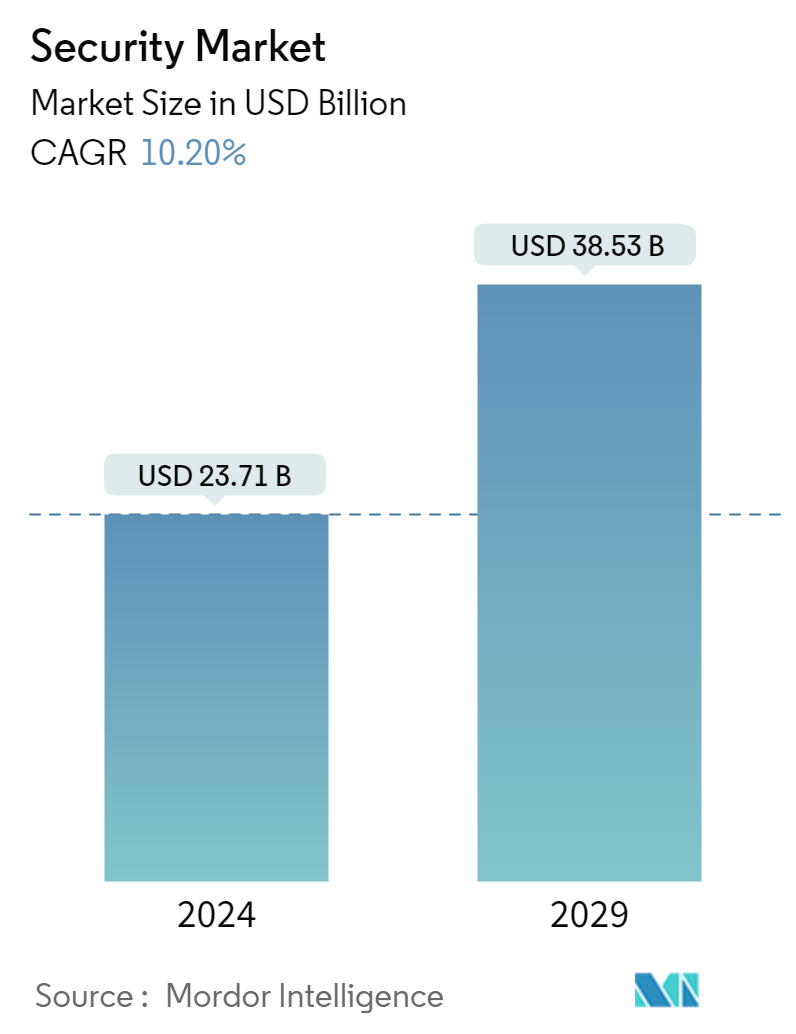
| Study Period | 2019 - 2029 |
| Market Size (2024) | USD 23.71 Billion |
| Market Size (2029) | USD 38.53 Billion |
| CAGR (2024 - 2029) | 10.20 % |
| Fastest Growing Market | Asia Pacific |
| Largest Market | North America |
Major Players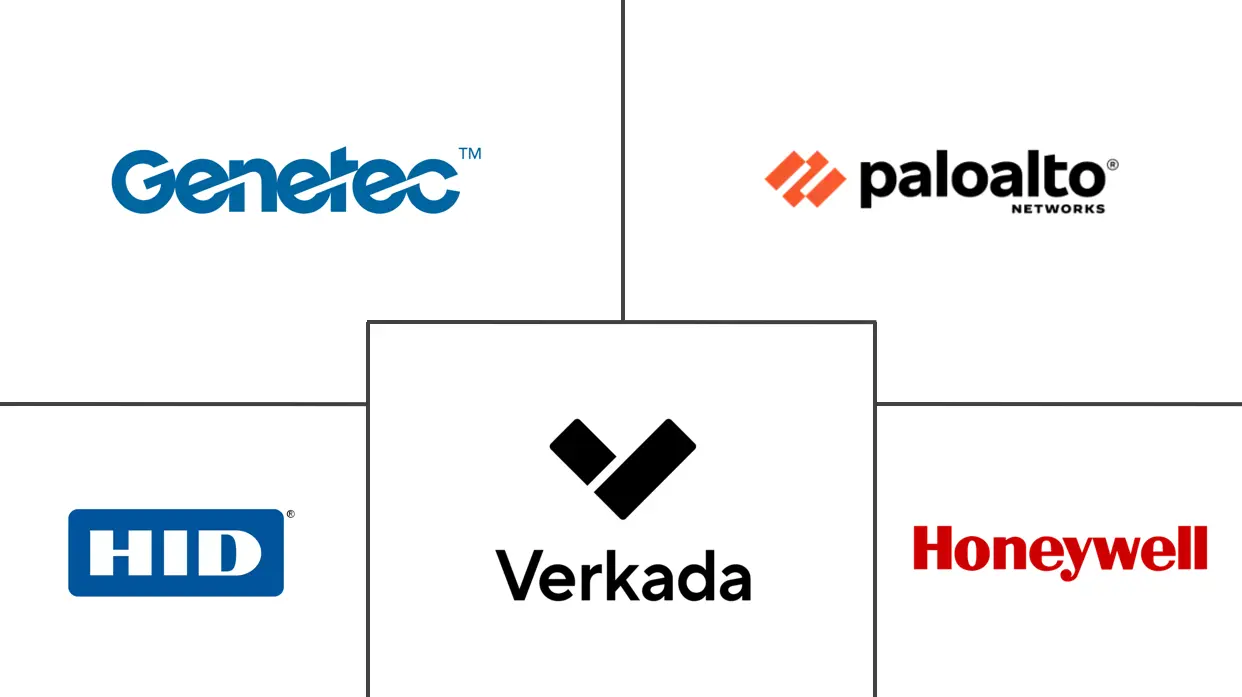
*Disclaimer: Major Players sorted in no particular order |
Security Market Analysis
The Security Market size is estimated at USD 23.71 billion in 2024, and is expected to reach USD 38.53 billion by 2029, growing at a CAGR of 10.20% during the forecast period (2024-2029).
- Technological advancements are reshaping the landscape of physical security. Innovations in surveillance technology, such as high-definition cameras and sophisticated video analytics, bolster the monitoring and response capabilities to security incidents. Access control systems now integrate biometric technologies and smart credentials, enhancing security and user convenience.
- Artificial Intelligence (AI) and machine learning are pivotal in refining threat detection and response. By analyzing vast datasets, AI algorithms can pinpoint patterns and anomalies that signal potential threats, thus boosting the accuracy and speed of detection. Moreover, AI-driven behavioral analytics can spot unusual activities or deviations from established norms, enabling proactive security measures.
- For instance, in August 2024, Palo Alto Networks unveiled its ‘Secure AI by Design’ product suite. These AI-powered cybersecurity solutions are tailored to counter AI-related threats and protect AI models. This suite offers visibility and control and specifically addresses emerging risks as businesses weave AI technologies deeper into their operations.
- As the Internet of Things (IoT) devices proliferate, the expanded attack surface has heightened the urgency to secure these interconnected devices. Tailored IoT security solutions are emerging to combat vulnerabilities unique to these devices. In April 2024, Cisco Systems Inc. rolled out ‘Hypershield,’ empowering customers to enforce security measures across diverse platforms, be it in the cloud, data centers, or among many IoT-enabled devices.
- As businesses increasingly transition to cloud-based infrastructures, ensuring the security of these environments has become paramount. Cloud security solutions are designed to safeguard data, applications, and services hosted in the cloud. In June 2024, Datadog Inc., a prominent monitoring and security platform for cloud applications, unveiled enhancements to its security product lineup. These include agentless scanning, data security, and code security, empowering DevOps and security teams to fortify their code, cloud environments, and production applications.
- The Zero Trust model, which posits that threats can originate internally and externally, mandates rigorous verification for every access request. This model is increasingly being adopted in cloud security strategies. In June 2024, Zscaler, a cloud security provider, bolstered its collaboration with Google. This expanded partnership aims to furnish enterprises with secure application access, robust data protection, and valuable security insights; all facilitated through three new security integrations.
- The market grapples with a few challenges. High implementation costs can be a significant barrier, especially for smaller organizations. The ever-evolving threat landscape demands constant updates and adaptations, placing a strain on resources and budgets. A shortage of skilled cybersecurity professionals complicates the effective deployment and management of advanced security solutions. Privacy concerns surrounding surveillance and monitoring technologies present additional hurdles, potentially inciting consumer resistance and regulatory challenges.
- The demand for robust security solutions surges as cities expand due to rapid urbanization and infrastructure development. Geopolitical tensions cast a shadow over the security landscape, prompting heightened investments in cybersecurity and physical security measures. This trend, coupled with an augmented defense and security budget, is driving a surge in the procurement of advanced surveillance and monitoring systems.
Security Market Trends
Commercial Sector Witnessing Demand
- Businesses increasingly invest in advanced technologies to protect physical assets like offices, equipment, and inventory from theft, vandalism, and unauthorized access. These include video surveillance systems, access control measures, and intrusion detection technologies.
- As businesses become more reliant on digital information, they are pouring significant resources into cybersecurity. They aim to shield sensitive data from breaches, ransomware, and other cyber threats. Key strategies include deploying network security solutions, utilizing encryption, and opting for secure cloud services.
- The surge in cyberattacks, ranging from phishing to ransomware, underscores the urgency for robust cybersecurity measures. In response, businesses are turning to advanced threat detection and response systems, leveraging AI-driven analytics and threat intelligence tools.
- According to data published by Clyde & Co., cyberattacks, data loss, and cyber extortion are some of the most significant risks to businesses according to the respondents. In the last year, 62% of the respondents cited cyberattacks as a significant threat.
- In a bid to bolster security, the commercial sector is turning to IoT and smart technologies. Solutions like smart locks, integrated alarm systems, and real-time monitoring enhance control and automation. With the growing shift to cloud computing, there's a rising demand for cloud-based security solutions. Businesses now prioritize scalable and flexible measures to safeguard their cloud infrastructure and data.
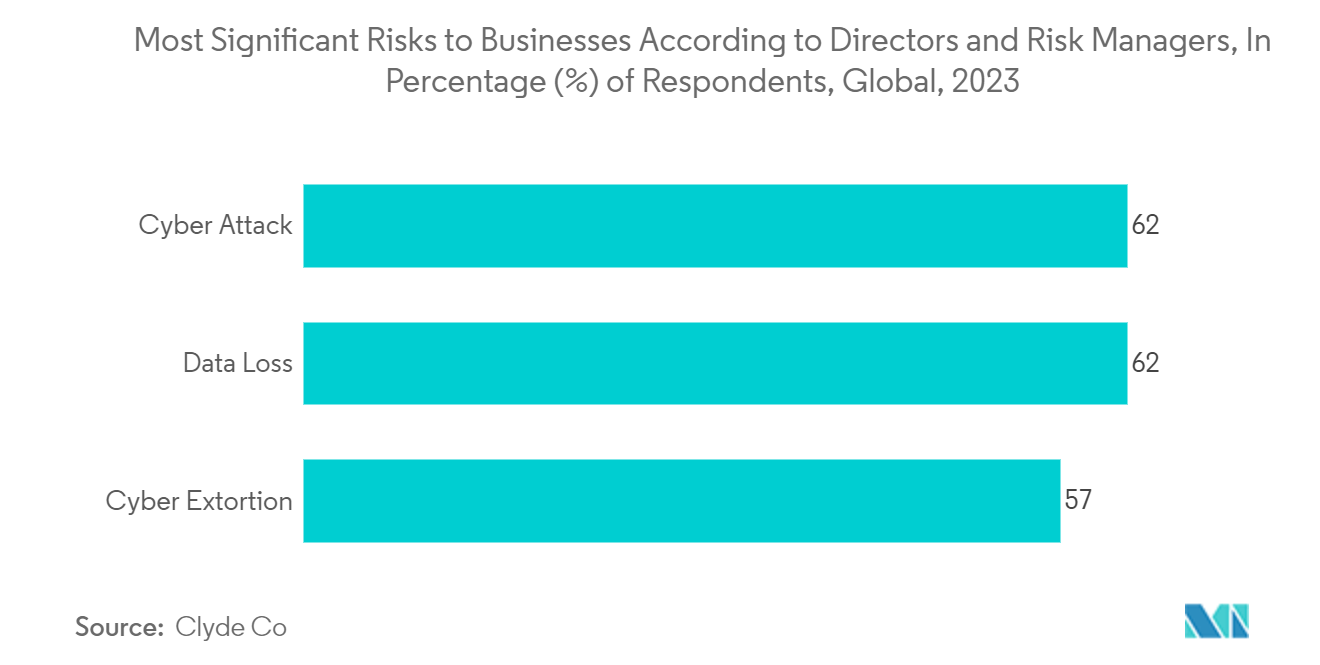
North America Holds the Largest Share
- North America stands at the forefront of global technological innovation. The region swiftly adopts cutting-edge security solutions, including AI-powered threat detection, biometric authentication, and cloud-based security platforms. Companies across diverse sectors are channeling significant investments into these advanced solutions, weaving in AI, machine learning, and data analytics to bolster real-time monitoring and predictive capabilities.
- North American enterprises widely deploy the Internet of Things, fueling the demand for IoT security solutions. As smart cities and infrastructures gain traction, there's a notable surge in physical security systems, such as connected video surveillance, access control, and alarm systems.
- With its expansive digital footprint and a treasure trove of valuable data, North America, especially the United States, has become a prime target for cybercriminals. The region is no stranger to high-profile data breaches, ransomware incidents, and intricate cyber espionage endeavors. Data from Baker Hostetler highlights that last year, the finance and insurance sector in the United States faced the brunt, shelling out an average ransom of USD 4.03 million.
- The US government emerges as a significant player in security investments, zeroing in on critical infrastructure protection and homeland security. Initiatives aimed at bolstering resilience, safeguarding government networks, and thwarting cyber espionage have spurred substantial financial commitments. The US Office of Management and Budget reported that the government allocated over USD 12 billion to cybersecurity this year, marking an uptick from the previous year.
- North America hosts many of the world's largest corporations, especially in technology, banking, and defense sectors. These companies rely on advanced systems to safeguard their physical and digital assets. With its substantial spending power, the commercial sector is primed to invest in cutting-edge security technologies.
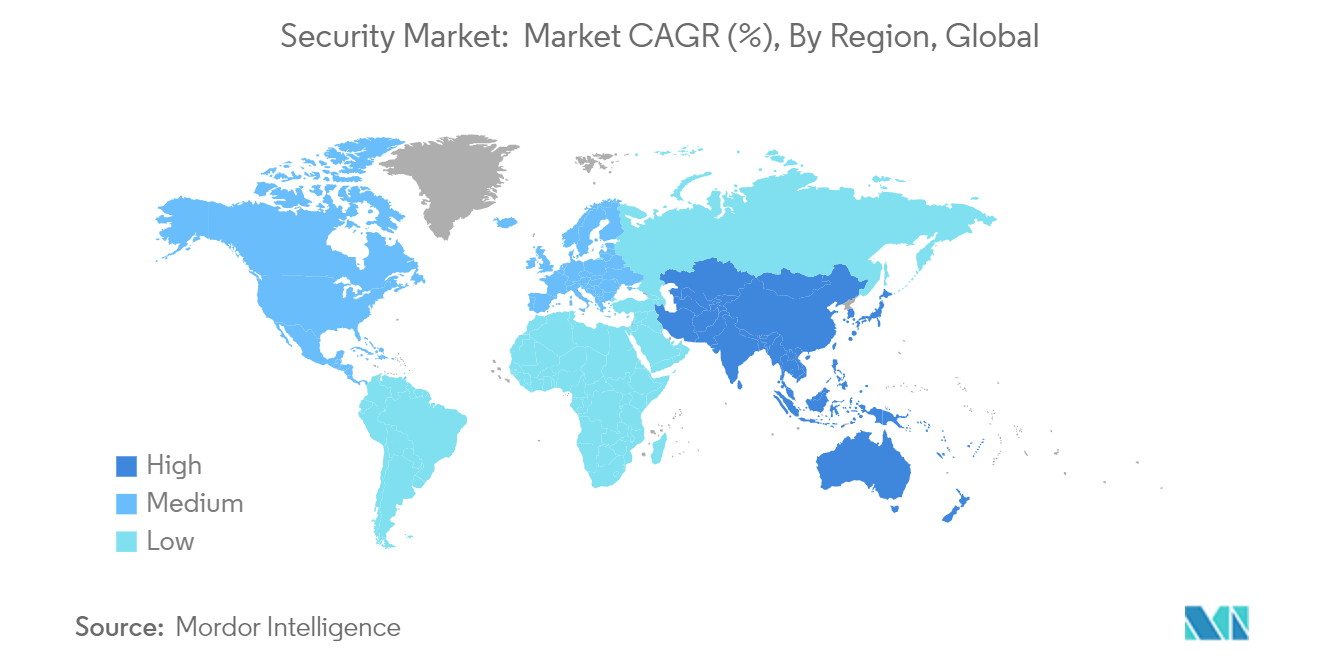
Security Industry Overview
The security market is fragmented and characterized by diverse players, from established multinational corporations to innovative startups. Major technology firms, specialized security companies, and integrators vie for market share through continuous innovation. The rapid evolution of security threats and technologies drives intense competition, with firms investing heavily in research and development to offer cutting-edge solutions. Players such as Verkada Inc., HID Global, Bosch, Genetec, Palo Alto Networks and many more operate in this market.
- April 2024: IBM Cloud partnered with Fortinet to introduce the Fortinet Virtual FortiGate Security Appliance (vFSA) on its platform. This new solution from Fortinet combines the robust features of its FortiGate hardware firewall with the adaptability of virtual appliances. The vFSA equips clients with the advanced security features of FortiGate's next-generation firewall (NGFW) throughout the IBM Cloud network. This design aims to safeguard clients' networks, especially those handling sensitive traffic and data, ensuring high availability.
- February 2024: Hikvision launched its second-generation professional access control products. These new offerings mark a substantial advancement in access management, introducing innovations in web management, flexible authentication, specialized access applications, and integrated security solutions. Hikvision's latest products boast extensive, robust features and functionalities, emphasizing seamless and efficient access management.
Security Market Leaders
-
Verkada Inc.
-
HID Global
-
Honeywell International Inc.
-
Genetec Inc.
-
Palo Alto Networks
*Disclaimer: Major Players sorted in no particular order
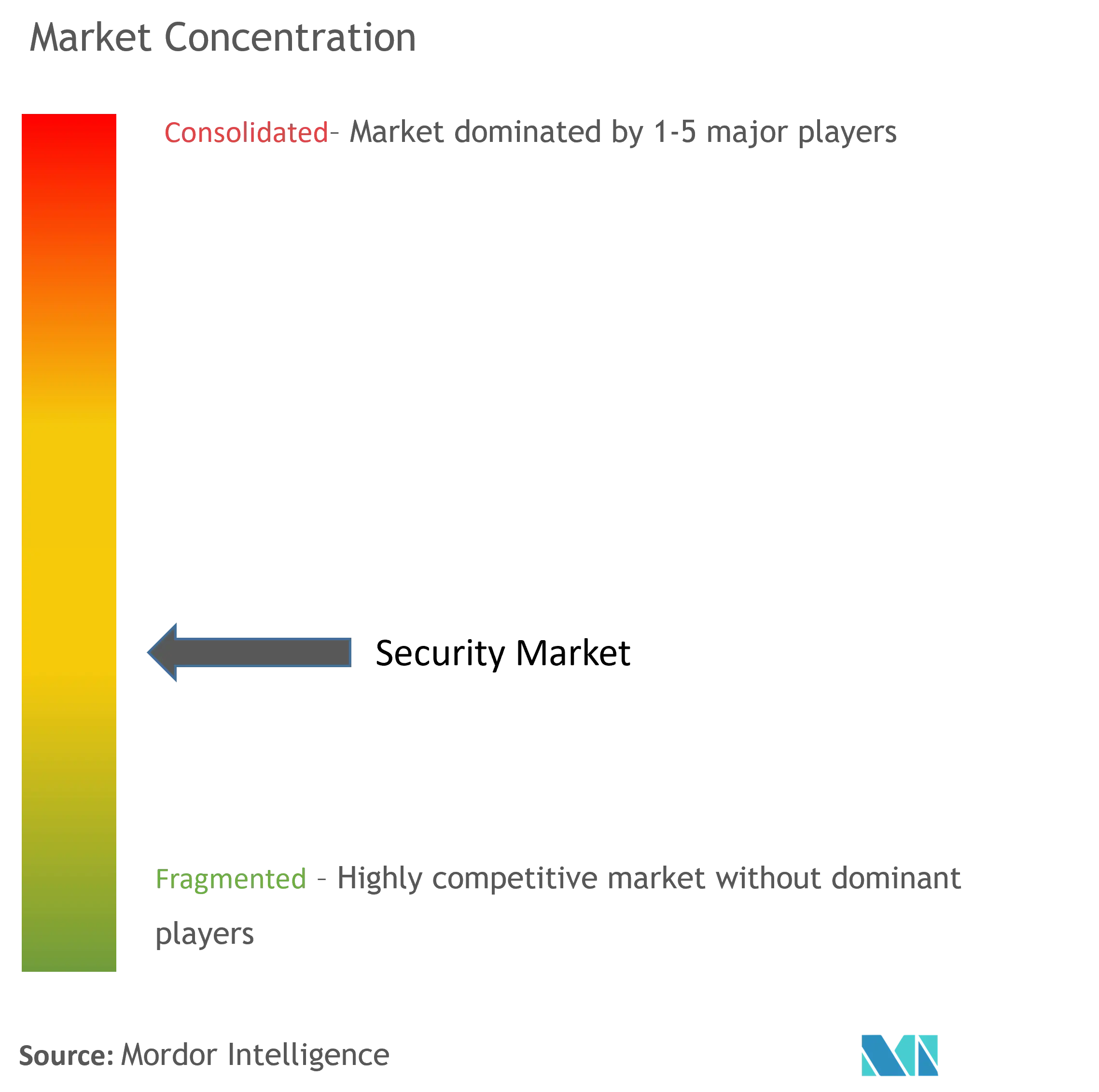
Security Market News
- August 2024: Alfred International, a subsidiary of GHT Door Hardware specializing in smart and connected locks, launched its patented Alfred ML2 Smart Mortise Lock with Z-Wave Long Range in the United States. The ML2, as per the company's claims, merges cutting-edge technology with a modern keypad and a unique design. This patented drive mechanism enables dealers to retrofit the ML2 into properties that previously used older mortise-style locks. Now available in the United States, the ML2 caters to property managers and homeowners who wish to upgrade to a smart mortise lock. This upgrade can be done without entirely replacing or re-keying the existing lock, thus sidestepping common installation challenges.
- May 2024: Palo Alto Networks, a global leader in cybersecurity, has partnered with IBM, a frontrunner in hybrid cloud and AI solutions, to deliver AI-driven security outcomes for their clients. Organizations are turning to comprehensive AI-backed security platforms as threats become more sophisticated and attack surfaces evolve. Through their collaboration, Palo Alto Networks and IBM seek to enhance security operations, thwart threats on a larger scale, and expedite incident remediation, all through a holistic AI-driven strategy.
Security Market Report - Table of Contents
1. INTRODUCTION
- 1.1 Study Assumptions and Market Definition
- 1.2 Scope of the Study
2. RESEARCH METHODOLOGY
3. EXECUTIVE SUMMARY
4. MARKET INSIGHTS
- 4.1 Market Overview
-
4.2 Industry Attractiveness - Porter's Five Forces Analysis
- 4.2.1 Bargaining Power of Suppliers
- 4.2.2 Bargaining Power of Consumers
- 4.2.3 Threat of New Entrants
- 4.2.4 Threat of Substitutes
- 4.2.5 Intensity of Competitive Rivalry
- 4.3 Impact of COVID-19 Aftereffects and Other Macroeconomic Factors on the Market
5. MARKET DYNAMICS
-
5.1 Market Drivers
- 5.1.1 Increasing Cyber Threats
- 5.1.2 Growth in IoT Devices
-
5.2 Market Restraints
- 5.2.1 Privacy Concerns
6. MARKET SEGMENTATION
-
6.1 By Security Type
- 6.1.1 Physical Security
- 6.1.1.1 Access Control
- 6.1.1.2 Video Surveillance
- 6.1.1.3 Intrusion Detection
- 6.1.1.4 Perimeter Security
- 6.1.2 Cyber Security
- 6.1.2.1 Network Security
- 6.1.2.2 End Point Security
- 6.1.2.3 Application Security
- 6.1.2.4 Cloud Security
- 6.1.2.5 Information Security
-
6.2 By End-user Vertical
- 6.2.1 Government and Public Sector
- 6.2.2 Commercial
- 6.2.3 Industrial
- 6.2.4 Residential
- 6.2.5 Healthcare
- 6.2.6 Education
- 6.2.7 Critical Infrastructure
-
6.3 By Solution Type
- 6.3.1 Hardware
- 6.3.2 Software
- 6.3.3 Services
-
6.4 By Deployment Type
- 6.4.1 On-premise
- 6.4.2 Cloud-based
-
6.5 By Geography***
- 6.5.1 North America
- 6.5.2 Europe
- 6.5.3 Asia
- 6.5.4 Australia and New Zealand
- 6.5.5 Latin America
- 6.5.6 Middle East and Africa
7. COMPETITIVE LANDSCAPE
-
7.1 Company Profiles*
- 7.1.1 Verkada Inc.
- 7.1.2 HID Global
- 7.1.3 AMAG Technology (Allied Universal)
- 7.1.4 Bosch Sicherheitssysteme GmbH
- 7.1.5 Axis Communications AB
- 7.1.6 Honeywell International Inc.
- 7.1.7 Johnson Controls
- 7.1.8 ADT Inc
- 7.1.9 Securitas Technology
- 7.1.10 Assa Abloy Group
- 7.1.11 Genetec Inc.
- 7.1.12 Palo Alto Networks
- 7.1.13 Fortinet Inc.
- 7.1.14 IBM Corporation
- 7.1.15 Cisco Systems Inc.
8. INVESTMENT ANALYSIS
9. FUTURE OF THE MARKET
** Subject To AvailablitySecurity Industry Segmentation
The global security market encompasses a wide range of solutions designed to protect physical and digital assets. It includes physical security systems like access control, video surveillance, and intrusion detection, as well as cybersecurity measures such as network protection, endpoint security, and cloud security. The market serves various sectors, including government, commercial, industrial, residential, and critical infrastructure. Key technologies driving the market include AI, IoT, and biometrics,
The study tracks the revenue generated from the sale of security products and services by various manufacturers and service providers worldwide. It also tracks the key market parameters, underlying growth influencers, and major manufacturers operating in the industry, which supports the market estimations and growth rates over the forecast period. The study further analyses the overall impact of macroeconomic factors on the market. The report’s scope encompasses market sizing and forecasts for the various market segments.
The security market is segmented by security type (physical security[access control, video surveillance, intrusion detection, and perimeter security], cyber security [network security, endpoint security, application security, cloud security, and information security]), end-user vertical (government and public sector, commercial, industrial, residential, healthcare, education, and critical infrastructure), solution type (hardware, software, and services), deployment type (on-premise and cloud-based), and geography (North America, Europe, Asia-Pacific, Latin America, and Middle East and Africa). The market sizes and forecasts are provided in terms of value (USD) for all the above segments.
| By Security Type | Physical Security | Access Control |
| Video Surveillance | ||
| Intrusion Detection | ||
| Perimeter Security | ||
| By Security Type | Cyber Security | Network Security |
| End Point Security | ||
| Application Security | ||
| Cloud Security | ||
| Information Security | ||
| By End-user Vertical | Government and Public Sector | |
| Commercial | ||
| Industrial | ||
| Residential | ||
| Healthcare | ||
| Education | ||
| Critical Infrastructure | ||
| By Solution Type | Hardware | |
| Software | ||
| Services | ||
| By Deployment Type | On-premise | |
| Cloud-based | ||
| By Geography*** | North America | |
| Europe | ||
| Asia | ||
| Australia and New Zealand | ||
| Latin America | ||
| Middle East and Africa |
Security Market Research FAQs
How big is the Security Market?
The Security Market size is expected to reach USD 23.71 billion in 2024 and grow at a CAGR of 10.20% to reach USD 38.53 billion by 2029.
What is the current Security Market size?
In 2024, the Security Market size is expected to reach USD 23.71 billion.
Who are the key players in Security Market?
Verkada Inc., HID Global, Honeywell International Inc., Genetec Inc. and Palo Alto Networks are the major companies operating in the Security Market.
Which is the fastest growing region in Security Market?
Asia Pacific is estimated to grow at the highest CAGR over the forecast period (2024-2029).
Which region has the biggest share in Security Market?
In 2024, the North America accounts for the largest market share in Security Market.
What years does this Security Market cover, and what was the market size in 2023?
In 2023, the Security Market size was estimated at USD 21.29 billion. The report covers the Security Market historical market size for years: 2019, 2020, 2021, 2022 and 2023. The report also forecasts the Security Market size for years: 2024, 2025, 2026, 2027, 2028 and 2029.
Security Industry Report
Statistics for the 2024 Security market share, size and revenue growth rate, created by Mordor Intelligence™ Industry Reports. Security analysis includes a market forecast outlook for 2024 to 2029 and historical overview. Get a sample of this industry analysis as a free report PDF download.



